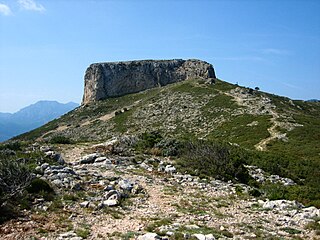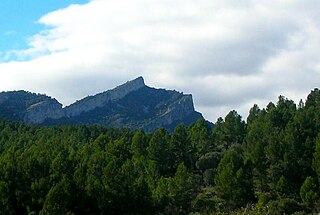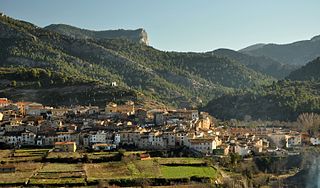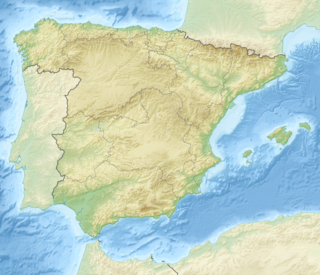| Serra de l'Espina | |
|---|---|
 Serra de l'Espina rising above Alfara de Carles | |
| Highest point | |
| Peak | L'Espina |
| Elevation | 1,181.6 m (3,877 ft) |
| Coordinates | 40°52′46.73″N0°21′43.93″E / 40.8796472°N 0.3622028°E Coordinates: 40°52′46.73″N0°21′43.93″E / 40.8796472°N 0.3622028°E |
| Geography | |
| Location | Baix Ebre |
| Parent range | Ports de Tortosa-Beseit |
| Geology | |
| Orogeny | Alpine orogeny |
| Type of rock | Karstic |
| Climbing | |
| Easiest route | Walk from Alfara de Carles |

Serra de l'Espina is a limestone mountain chain located at the north-eastern end of the Iberian System. It connects the Ports de Tortosa-Beseit mountain massif with the Catalan Pre-Coastal Range. [1]

Limestone is a carbonate sedimentary rock that is often composed of the skeletal fragments of marine organisms such as coral, foraminifera, and molluscs. Its major materials are the minerals calcite and aragonite, which are different crystal forms of calcium carbonate (CaCO3). A closely related rock is dolomite, which contains a high percentage of the mineral dolomite, CaMg(CO3)2. In fact, in old USGS publications, dolomite was referred to as magnesian limestone, a term now reserved for magnesium-deficient dolomites or magnesium-rich limestones.
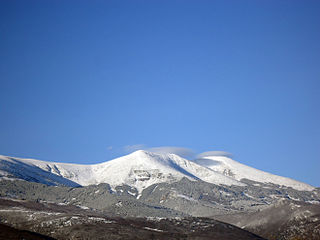
The Iberian System, is one of the major systems of mountain ranges in Spain. It consists of a vast and complex area of mostly relatively high and rugged mountain chains and massifs located in the central region of the Iberian Peninsula, but reaching almost the Mediterranean coast in the Valencian Community in the east.

Ports de Tortosa-Beseit, also known as Ports de Beseit, or simply as Els Ports[əls ˈpɔɾts] or Lo Port[lu ˈpɔɾt] by locals, is a limestone mountain massif located at the north-eastern end of the Sistema Ibérico, a complex system of mountain ranges and massifs in the centre of the Iberian Peninsula. Its highest point is Mont Caro, 1,441 m. Rivers such as the Matarranya and the Sénia have their source in these mountains.

